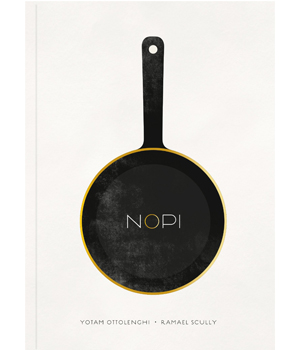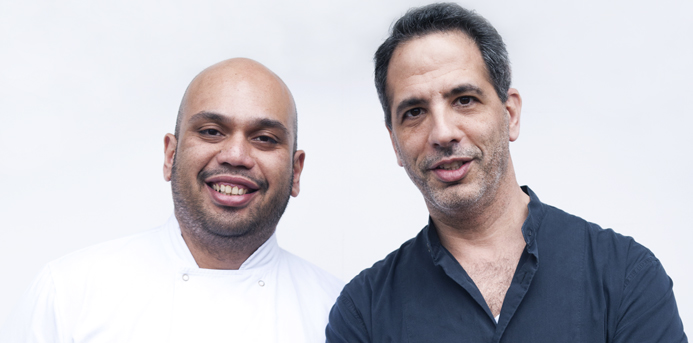The cookbooks of Yotam Ottolenghi are magic. When you make his recipes, you are instantly transported to a different place, filled with color and light, vibrant flavors and intoxicating aromas. It’s a veritable carnival of the senses.
The best-selling author of five cookbooks (“Ottolenghi: The Cookbook,” “Plenty,” “Jerusalem,” “Plenty More,” and “NOPI: The Cookbook”) comes to town Oct. 24 to appear at the 2015 Chicago Humanities Festival at Northwestern’s Cahn Auditorium. As tickets will most likely be scarce, we are especially thrilled to be able to share our recent interview with “Citizen Chef, Global Foodie” Yotam Ottolenghi. It might just be the closest you can get to this fascinating and absurdly talented man.
Make It Better: Not every great chef is a writer, but you are. That is one of the chief delights in reading your books; your passion and philosophy come through with clarity on every page. It is especially true with “Jerusalem,” clearly a labor of love for you and your co-author Sami Tamimi. What was the impetus for this prize-winning cookbook?
Ottolenghi: The idea started with what could have been a throwaway comment from Noam Bar (who co-founded Ottolenghi with Sami and I). We were having one of our regular dinners at Sami’s house and something that we were eating – I think it was Mejadra – took Sami and I on a great long trip down memory lane about the different ways our families used to cook the dish. Noam said that there was a book to be written. We initially wrote off the idea – we didn’t think anyone would be interested in all these traditional recipes we grew up with – but the idea took hold and we realized that, so long as we allowed ourselves certain freedoms to adapt recipes – tradition is a big thing to respect, particularly when there are many, many different ways to make hummus! – there was a story and recipes there that we were keen to share. It was a labor of love and a really special journey for Sami and I to take, exploring old recipes, awakening dormant memories, adapting things for the modern cook. We loved it.
To say that you’ve taken the hearts and kitchens of America by storm is a vast understatement. People have been sounding the death knell of the physical book since the advent of the e-book and the tablet, but cookbooks – yours in particular – have proven a notable exception. Why do you think your books have been so spectacularly well received, not only in Great Britain, but America, Australia and beyond?
There are lots of cookery books that are selling well. It’s difficult to always pinpoint the “why”: it’s often the result of lots of different factors coming together. The market is really keen and receptive towards experimenting with new and bold ingredients, for example, and there is a movement towards cooking more at home rather than always eating out. Books are also often looking more and more beautiful so that could account for continued book sales (rather than people being satisfied with being able to find a recipe on-line).
In terms of the specifics of my books, it’s hard for me to be the one to say: I know that my recipes have a reputation of working, which builds confidence in my readers. A lot of the recipes have a built-in “wow” factor, which I’m told makes people delighted when they serve something to their friends. I only publish a recipe if I think it is very delicious, know that it is utterly tried and tested and sticks with me as being something a little bit different which makes me smile. The sales would suggest, I’m very lucky to say, that others agree!
These are books that people actually cook from, not just regard as window dressing or coffee table paperweights. As I’m sure you know, Ottolenghi recipe parties and book clubs are quite popular here in the States. What are some of your go-to cookbooks and/or cookbook authors? Who has inspired you?
A lot of people have inspired me, and it never stops. I have a lot of books in the test kitchen and at home and am constantly flicking through them and feeling inspired to make things on the weekend. It’s difficult to lock down a list – its constantly changing – but over the past few months, say, I’ve been excited to read through the cookbooks from Bar Tartine, Pigeon, Dan Hong, Honey & Co, Movida, Karen Martini. It’s a long list, though, always on-going.
For all my good intentions to cook new things at home, though, more often than not I’m afraid the range of fruits and vegetables at the grocers at the end of our road is so good that I tend to just head down there and let the ingredients dictate the menu. I can have something very particular in mind and then return with things for a different dish entirely!
It seems that many of today’s cookbooks are more style than substance, but your books combine approachable, crave-able recipes with great photography. With the exception of your first book, “Ottolenghi: The Cookbook,” Jonathan Lovekin has been the food photographer for all of your books (and the American cover of “Ottolenghi”). Clearly you share a vision. What do you look for in a food photographer? How did you first connect with him? And did you do your own food styling?
Jonathan and I have a really great relationship. We have a shared vision and approach to food styling but I think it’s precisely the fact that we would never talk in terms of “food styling” that we really connect. Jonathan and I are far more likely to be excited about catching a dish and photographing it before it is “finished” or composed: when the steam is rising off vegetables braising in a pan on the stove, for example, or the icing sugar when it is being dusted onto some still-warm financiers.
“Plenty More” was very much a book about process so we couldn’t have been happier photographing this book: we were often taking pictures and deeming them “the one” before a dish had even come close to a serving platter.
 “NOPI: The Cookbook” was more of a challenge, as restaurant dishes are often, by definition, far more composed and involved than dishes designed at the outset for the home cook will be. We were working with a very specific aesthetic in mind – led by the design and feel of the NOPI restaurant itself – so this was our starting point. It took us a day or two to get into our stride – it was a bit like an author or musician must feel working in a completely different genre from the one they are used to, I imagine – but we both absolutely loved the challenge and couldn’t have been happier with the result. The design team at Here Design, headed up by Caz Hildebrand, also played a huge part in the overall design and feel of the books: they continuously delight, surprise and impress me!
“NOPI: The Cookbook” was more of a challenge, as restaurant dishes are often, by definition, far more composed and involved than dishes designed at the outset for the home cook will be. We were working with a very specific aesthetic in mind – led by the design and feel of the NOPI restaurant itself – so this was our starting point. It took us a day or two to get into our stride – it was a bit like an author or musician must feel working in a completely different genre from the one they are used to, I imagine – but we both absolutely loved the challenge and couldn’t have been happier with the result. The design team at Here Design, headed up by Caz Hildebrand, also played a huge part in the overall design and feel of the books: they continuously delight, surprise and impress me!
Because two of your cookbooks—“Plenty” and “Plenty More”—are vegetable-centric, many people think of you as a vegetable guru. And of course you are a champion of locally sourced, freshly prepared cuisine. Is farm-to-table as big a trend in England as it is here in the states? What food and restaurant trends do you see on the horizon?
It’s not as big a trend as it is in the States (is anything ever?), but it is certainly a movement which has a lot of traction at the moment. There are lots of food and restaurant trends always coming and going: at the moment people seem to be fans of shorter or set menus – a few things, done well, is often more reassuring and relaxing than some great long menu full of too many options – and last minute/casual dining in the form of the no-reservations policy. Paying for your meal before you eat is something that some customers are also fans of – again, this can help in the relaxed vibe of an evening and also helps restaurants secure against bookings not being honored.
NOPI, your newest restaurant, is the inspiration for your new cookbook. How does the food there differ from the Ottolenghi delis? What (or who) inspired the change?
Recipes designed for a restaurant will necessarily be more composed and often more involved than recipes first designed for the home cook. That’s what makes eating out such a joy! When NOPI was conceived, we felt that the Ottolenghi family was ready for something a bit more “grown up” and formal, as it were, than our delis. NOPI is our grown-up child!
There are certain traits which connect NOPI to the delis – there are some salads on display as you walk in, for example, and there will be certain ingredients which people think of as “Ottolenghi”: the sumac martini, for example, or za’atar oven-roasted vegetables – but then there is a distinct Asian twist to the menu that was brought to the table by Ramael Scully, who I’ve co-written the book with. Scully has a Malaysian-Australian heritage and brought a lot of ingredients, which were new to me to the table, [such as] pandan leaves and banana leaves, miso and tamarind and so forth.
Both the NOPI restaurant and book have a different feel to the delis [than] any of my previous books, as well: the trademark red of the delis is replaced by the trademark NOPI gold, for example. We have worked really hard to adapt the NOPI recipes for the home cook, though. There are some recipes where people need to be a little bit chef-like – getting everything ready for a dish before they start cooking, for example – but they are all completely do-able at home and don’t require any fancy kit or anything.
Last question – what Chicago-area restaurants are you most excited about/planning on visiting while you are here for the Humanities Festival in October?
I’m afraid I haven’t had a chance to properly look into the Chicago food scene but I do know how vibrant it is so I’m looking forward to my visit.
More from Make It Better:

